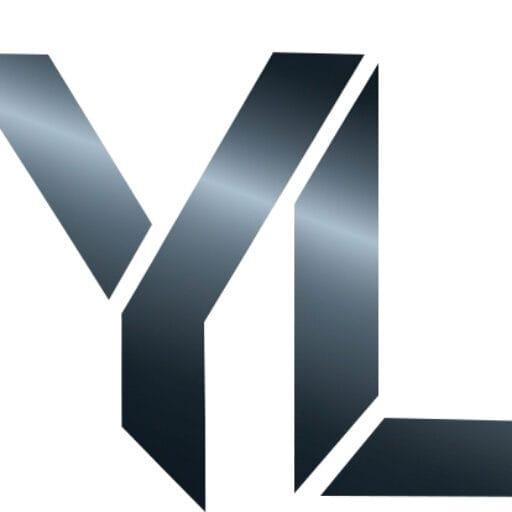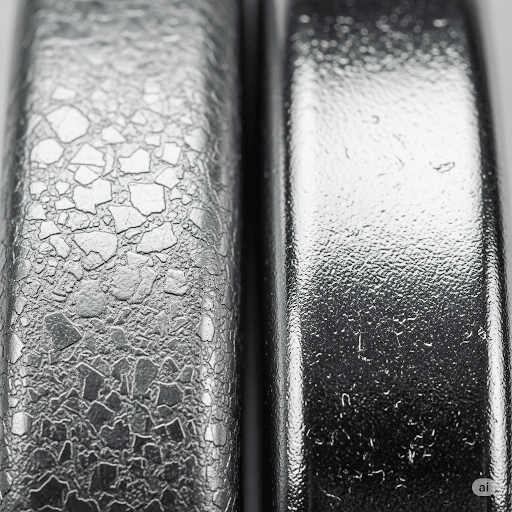Finding the right surface finish for your CNC machining parts can feel like navigating a minefield. You select a coating, hoping for robust corrosion protection, only to face unexpected part failure or premature rust, disrupting your entire project timeline.
The stakes are high. A poor choice can lead to catastrophic hydrogen embrittlement in high-strength components, causing them to fracture under stress. This isn’t just a quality issue; it’s a critical safety and financial risk that undermines the integrity of your precision CNC milling work.
This guide illuminates the fundamental differences between DBL 9441.50 (zinc flake coating) and zinc-nickel alloy plating. We provide the clarity you need to select the ideal protective layer, ensuring your CNC machining components deliver exceptional performance and longevity.
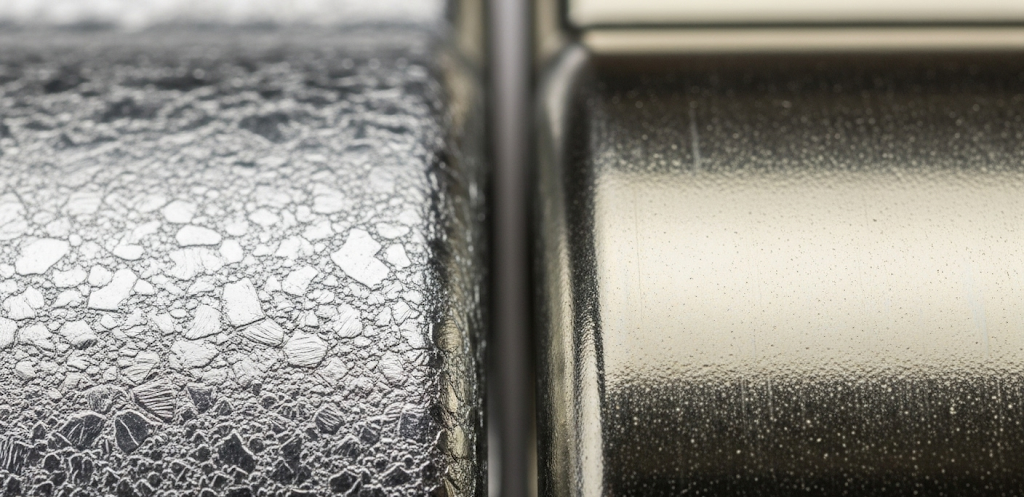
Are DBL 9441.50 (zinc flake) and zinc-nickel alloy plating the same surface treatment? No, they are entirely different technologies. Zinc flake coating is a non-electrolytic process that physically applies a paint-like layer of zinc and aluminum flakes. Conversely, zinc-nickel alloy plating is an electrolytic process that electrochemically deposits a true metal alloy layer onto the part’s surface.
Understanding this core distinction is crucial for anyone involved in CNC machining. While both aim to prevent corrosion, their methods, properties, and ideal applications vary significantly. Consequently, choosing the correct one impacts everything from component durability to safety. Therefore, let’s delve deeper into what sets these two vital CNC milling finishes apart.
Process & Principle: A Tale of Two CNC Machining Finishes
DBL 9441.50 (Zinc Flake Coating): A Non-Electrolytic Shield
The application of zinc flake coating is a mechanical bonding process. It avoids using an electric current, which is a critical differentiator in CNC machining.
Parts undergo a dip-spin or spray application. A specialized liquid containing tiny zinc and aluminum flakes suspended in a binder is applied. The components are then baked in an oven to cure the coating, creating a robust, layered protective shield. This method is common for parts produced through CNC milling.
Zinc-Nickel Alloy Plating: An Electro-Chemical Bond
In contrast, zinc-nickel alloy plating is a classic electroplating process. This technique forges a new metallic layer right on the substrate.
The CNC machining part is submerged in an electrolyte bath and acts as the cathode. An electric current is introduced, causing zinc and nickel ions in the solution to deposit onto the part’s surface. This creates a fully integrated, dense, and uniform metallic alloy layer. Precision CNC milling requires such consistent finishes.
Composition Deep Dive: Flakes vs. Alloy
The Structure of Zinc Flake Coatings
Imagine countless microscopic fish scales layered tightly together. That is the structure of a zinc flake coating after CNC machining.
This lamellar structure of zinc and aluminum flakes, held by a binder, creates a formidable physical barrier against corrosive elements. The overlapping flakes create a long, tortuous path for moisture and chemicals to penetrate, significantly slowing down corrosion.
The Nature of Zinc-Nickel Alloy
Zinc-nickel plating isn’t a simple layer; it’s a genuine metal alloy. The process forms a new, single-layer of zinc-nickel on the atomic level.
Typically composed of 12-15% nickel, this alloy is inherently more noble and resistant to corrosion than pure zinc. This makes it a preferred choice for high-performance CNC milling applications where durability is paramount. Many projects at ly-machining leverage this advanced coating.
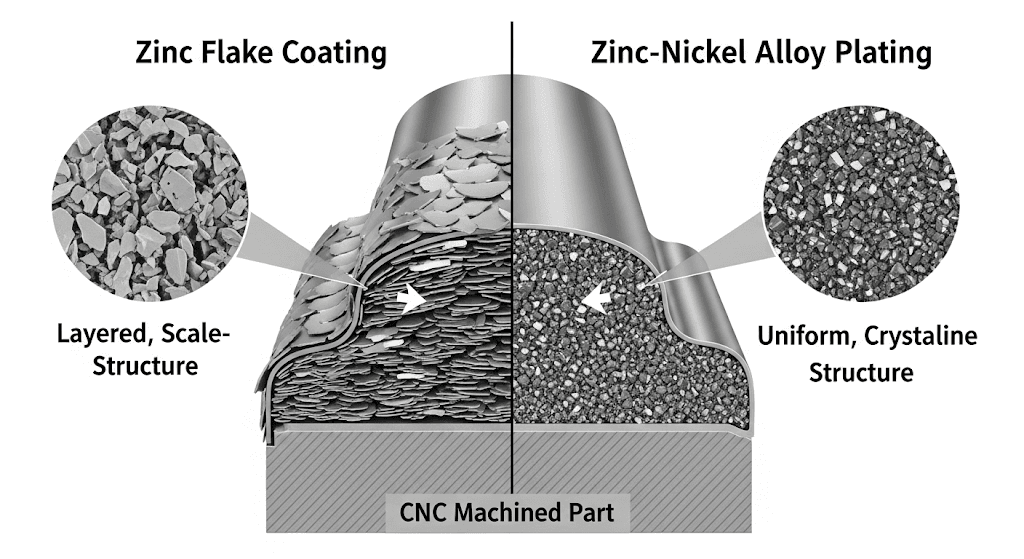
The Critical Risk: Unpacking Hydrogen Embrittlement
Why Zinc Flake Coating is the Safer Bet for High-Strength Steel
A significant advantage of the zinc flake process is its complete avoidance of hydrogen embrittlement. This is a crucial consideration in CNC machining of high-strength steel.
Because the process is non-electrolytic, no water electrolysis occurs, meaning no hydrogen atoms are generated to be absorbed by the steel. This makes it an ideal choice for safety-critical components like grade 10.9 or higher bolts, springs, and chassis parts, often produced via CNC milling.
The Inherent Hydrogen Risk in Zinc-Nickel Plating
The electroplating process for zinc-nickel alloy inherently produces hydrogen atoms at the part’s surface (the cathode).
These atoms can permeate the crystal lattice of high-strength steels, causing a loss of ductility and leading to unexpected, brittle fractures under load. While a post-plating baking process (de-embrittlement) can remove most of the trapped hydrogen, the risk is never entirely eliminated, a key factor for any CNC machining project.
Corrosion Protection Mechanisms
How Zinc Flake Defends Your CNC Machining Parts
Zinc flake coatings offer a dual-action defense system. The first is barrier protection, where the layered flakes physically block corrosive agents.
Secondly, it provides cathodic protection. Zinc is more electrochemically active than steel. If the coating is scratched, the surrounding zinc will sacrificially corrode to protect the exposed steel base metal of the CNC milling component.
The Superior Resistance of Zinc-Nickel Alloy
Zinc-nickel alloy also provides both barrier and cathodic protection. However, its primary strength lies in the inherent corrosion resistance of the alloy itself.
The presence of nickel significantly slows the corrosion rate of the zinc, providing longer-lasting protection in harsh environments. This makes it highly suitable for CNC machining components in the automotive and aerospace sectors. For demanding projects, ly-machining often recommends this robust finish.
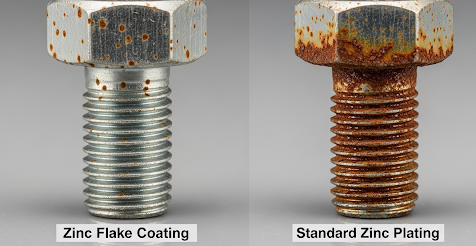
Aesthetic and Dimensional Control in CNC Milling
Appearance and Uniformity of Zinc Flake
Zinc flake coatings typically present a matte, silvery-gray finish, although black and other colors are available (DBL 9441.50 is specified as black).
Coating uniformity can be a challenge on complex CNC machining geometries, as pooling or thinning may occur in recessed areas or on sharp edges.
Precision and Appearance of Zinc-Nickel
Zinc-nickel plating often provides a brighter, more metallic appearance. It also allows for more precise control over the coating thickness.
By carefully managing the electric current and plating time, a highly uniform and consistent layer can be achieved, which is essential for CNC milling parts with tight tolerances.
Feature Comparison Table
| Feature | DBL 9441.50 (Zinc Flake Coating) | Zinc-Nickel Alloy Plating |
| Process Principle | Non-electrolytic (dip-spin, bake) | Electrolytic (electroplating) |
| Coating Composition | Layered zinc & aluminum flakes in a binder | A true zinc-nickel metal alloy (12-15% Ni) |
| Hydrogen Embrittlement Risk | None. Ideal for high-strength steel. | High risk. Requires post-bake de-embrittlement. |
| Protection Mechanism | Barrier & Sacrificial Cathodic Protection | Superior Alloy Resistance & Cathodic Protection |
| Typical Thickness | 8-15 µm | 5-25 µm, highly controllable |
| Appearance | Matte silver-gray or black | Bright or dull metallic finish |
| Ideal CNC Machining Use | High-strength fasteners, springs, chassis parts | Brake systems, fuel lines, aerospace components |

Typical Applications in CNC Machining
Where DBL 9441.50 Excels
This coating is the go-to choice for the automotive industry, especially for components where hydrogen embrittlement is a non-negotiable risk.
Think of high-tensile bolts, clips, springs, and structural brackets that are central to vehicle safety and integrity. The reliability of the CNC machining process is matched by the safety of the finish.
Where Zinc-Nickel Alloy Shines
Zinc-nickel is specified for CNC milling parts that face extreme corrosive and high-temperature environments.
Its applications are common in automotive and aerospace sectors for components like brake calipers, fluid connectors, and engine bay parts where superior wear and corrosion resistance are demanded. At ly-machining, we handle numerous CNC machining projects requiring this level of protection.
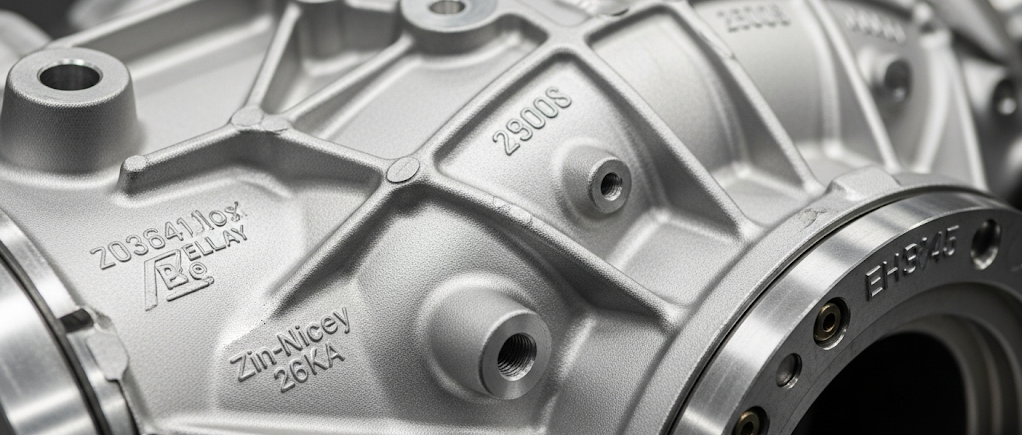
Related Questions
Can You Substitute Zinc Flake for Zinc-Nickel Plating?
No, they are not directly interchangeable without careful engineering evaluation. The choice depends heavily on the base material’s strength, the part’s function, and its operating environment. Substituting a non-embrittling coating for an electrolytic one on a high-strength steel part, for instance, could lead to catastrophic failure. Always consult with your CNC machining and finishing expert.
Which Finish is More Environmentally Friendly?
This is a complex question. Zinc flake coatings are typically free of harmful hexavalent chromium (Cr6+) and use water-based or solvent-based carriers that have environmental considerations. Modern zinc-nickel plating has also moved towards trivalent chromium passivates, which are less toxic. The overall environmental impact depends on the specific chemistry and waste treatment processes used by the CNC machining supplier.
Frequently Asked Questions
1. What is the main reason to choose DBL 9441.50 over zinc-nickel?
The primary reason is the complete absence of hydrogen embrittlement risk. For any CNC machining of high-strength steel parts (e.g., grade 10.9 bolts or higher), DBL 9441.50 provides peace of mind that the material’s integrity has not been compromised during the coating process.
2. Is zinc-nickel alloy plating more corrosion resistant than zinc flake?
Generally, yes. The zinc-nickel alloy itself is chemically more stable and corrodes at a much slower rate than the pure zinc used in flake coatings. In aggressive salt spray tests, zinc-nickel often outperforms zinc flake, lasting longer before showing signs of red rust on the underlying steel. This is a key factor for critical CNC milling parts.
3. How does the cost of these two CNC machining finishes compare?
Costs can be comparable but vary based on part geometry, size, and required volume. The zinc-nickel electroplating process can sometimes be more complex due to the need for post-treatment baking to mitigate hydrogen embrittlement, which can add to the overall cost. For a precise quote on your CNC machining project, contact the experts at ly-machining.
